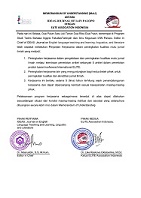"Post-Stroke Aphasia: A Psycholinguistic Approach to Speech Disorder Identification"
DOI:
https://doi.org/10.24256/ideas.v12i2.6218Keywords:
Speech Disorder, Post-Stroke, Psycholinguistic StudiesAbstract
This study aims to identify changes in the way individuals speak after a stroke based on psycholinguistic studies. The methods used to obtain information are descriptive qualitative and literature review. Information was obtained from interviews with respondents who had had a stroke. The respondent is a woman and she is 55 years old. The results showed that there were many changes experienced by individuals both in terms of physical social and emotional after a stroke. The most significant change is in the way individuals speak. Damage to the brain causes the patient to experience a stroke and its implications for other body nerves. One of them is speech disorders (speech aphasia). In conclusion, the brain and language influence each other both in processing language, acquiring language and understanding language. Therefore, if there is damage to the brain, it is difficult or even impossible for humans to process, produce and understand a language.
References
Adhi, Kusumastuti dan Ahmad Mustamil Khoiro. Metode Penelitian Kualitatif, Semarang: Lembaga Pendidikan Sukarno Pressindo (LPSP), 2019. hlm. 9
Alya Novita, F., & Kuntarto, E. (2020). GANGGUAN WICARA AFASIA PADA PENDERITA STROKE. Repository Unja.
Anisah, Z. (2019). Relevansi operasional bahasa dengan otak manusia. Stilistika: Jurnal Pendidikan Bahasa dan Sastra, 12 (2), 187-196.
Arief S, Nur. 2015. “Gangguan Fonologi Keluaran Wicara Pada Penderita Afasia Broca Dan Afasia Wernicke: Suatu Kajian Neurolinguistik. Jurnal Neurolinguistik. 6 (2).
Fadhilasari, I. (2022). Gangguan Berbahasa Tataran Fonologis Pada Tuturan Penderita Stroke Iskemik: Kajian Psikolinguistik. Fon: Jurnal Pendidikan Bahasa dan Sastra Indonesia, 18(1), 152-165.
Gunawan, D. (2008). Buku Artikulasi. Univesitas Pendidikan Indonesia. Jur._Pend._Luar_Biasa/1962112119840 31
Herlambang, A., Indriarini, M. Y., & Maharina, F. D. (2021). Pengaruh Terapi Wicara Terhadap Peningkatan Kemampuan Bicara Pada Penderita Stroke Dengan Afasia Motorik: Literature Review. Jurnal Kesehatan, 9(2), 65-72.
Husnaini, H. (2022). Development of Self Esteem-Oriented Micro Teaching Materials for IAIN Palopo English Education Students. IDEAS: Journal on English Language Teaching and Learning, Linguistics and Literature, 10(1), 538-560.
Kusumoputro, S dan Lily Sidiarto, (2009). Afasia: Gangguan Berkomunikasi Pascastroke Otak. Jakarta: Universitas Indonesia.
LH Santoso, Kamus Praktis Bahasa Indonesia, (Surabaya: CV. Pustaka Agung Harapan Surabaya)
Masruddin, Hartina, S., Arifin, M. A., & Langaji, A. (2024). Flipped learning: facilitating student engagement through repeated instruction and direct feedback. Cogent Education, 11(1), 2412500.
Pahlefi, M. R. (2019). Hubungan Bahasa Dengan Otak.
Prihatin, L. W., Kristiyawati, S. P., & SN, M. S. A. (2017). Perbedaan Efektivitas Terapi AIUEO dan Melodic Intonation Therapy (MIT) terhadap Waktu Kemampuan Bicara pada Pasien Stroke dengan Afasia Motorik di Rumah Sakit Panti Wilasa Citarum Semarang. Karya Ilmiah, 6(1).
Purnamawati, Indri dkk. (2018). “Kesalahan fonologi pada penderita afasia broca pascastroke dalam tinjauan psikolinguistik”. Jurnal psikolinguistik, Uniba. 1(1).
Puspitasari, D. (2017). Pengaruh terapi AIUEO terhadap kemampuan komunikasi pada afasia motorik pasien pasca stroke di kota pontianak. ProNers, 3(1).
Sastra, G. (2009). “Ekspresi Verbal Penderita Stroke: Suatu Analisis Neurolinguistik”. Jurnal Psikolinguistik, 9(12).
Sofiatun, I., Kristiyawati, S. P., & Purnomo, S. E. C. (2016). Efektifitas Terapi AIUEO dan Terapi The Token Test terhadap Kemampuan Berbicara Pasien Stroke yang Mengalami Afasia Motorik di RS Mardi Rahayu Kudus. Jurnal Ilmu Keperawatan dan Kebidanan, 8(2).
Suherman, A. 2005. Psicholinguistik. Bandung: Program Pendidikan Bahasa
Arab FPBS UPI.
Wahyu, A., Wati, L., & Fajri, M. (2019). Pengaruh Terapi AIUEO terhadap Kemampuan Bicara Pasien Stroke yang Mengalami Afasia Motorik. Journal of Telenursing (JOTING), 1(2), 226-235.
Wardhana, W. A. (2011). Strategi Mengatasi & Bangkit dari Stroke. Yogyakarta: Pustaka Belajar.
Downloads
Published
Issue
Section
Citation Check
License
Copyright (c) 2025 Fadhliyah Rahmah Muin, Cinta Lembang

This work is licensed under a Creative Commons Attribution-ShareAlike 4.0 International License.
Authors retain copyright and grant the journal right of first publication with the work simultaneously licensed under an Attribution-ShareAlike 4.0 International (CC BY-SA 4.0) that allows others to share the work with an acknowledgement of the work's authorship and initial publication in this journal.
Authors are able to enter into separate, additional contractual arrangements for the non-exclusive distribution of the journal's published version of the work (e.g., post it to an institutional repository or publish it in a book), with an acknowledgement of its initial publication in this journal.
Authors are permitted and encouraged to post their work online (e.g., in institutional repositories or on their website) prior to and during the submission process, as it can lead to productive exchanges, as well as earlier and greater citation of published work (See the Effect of Open Access)



